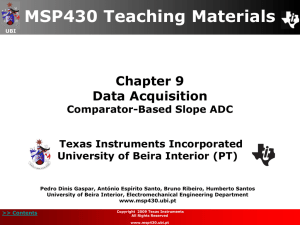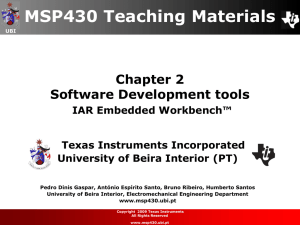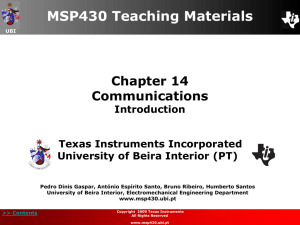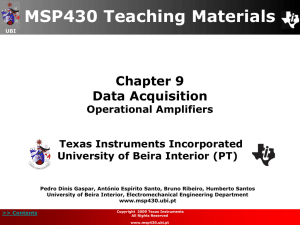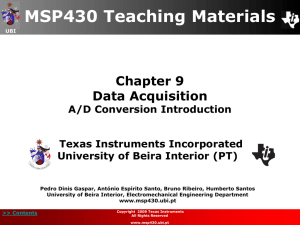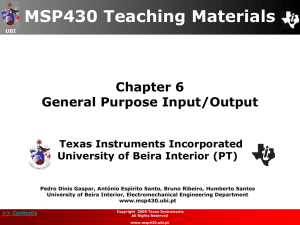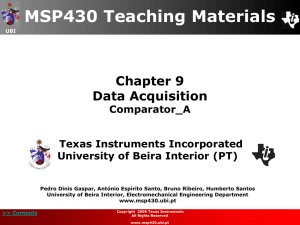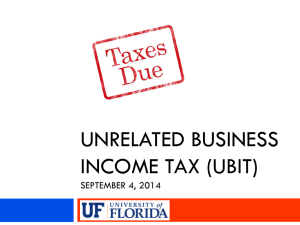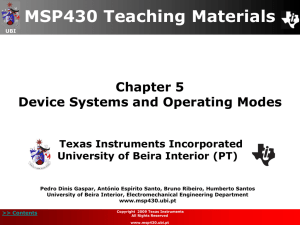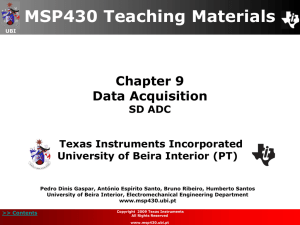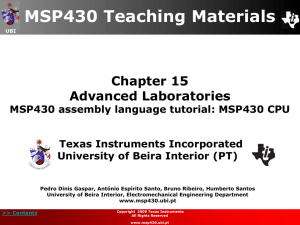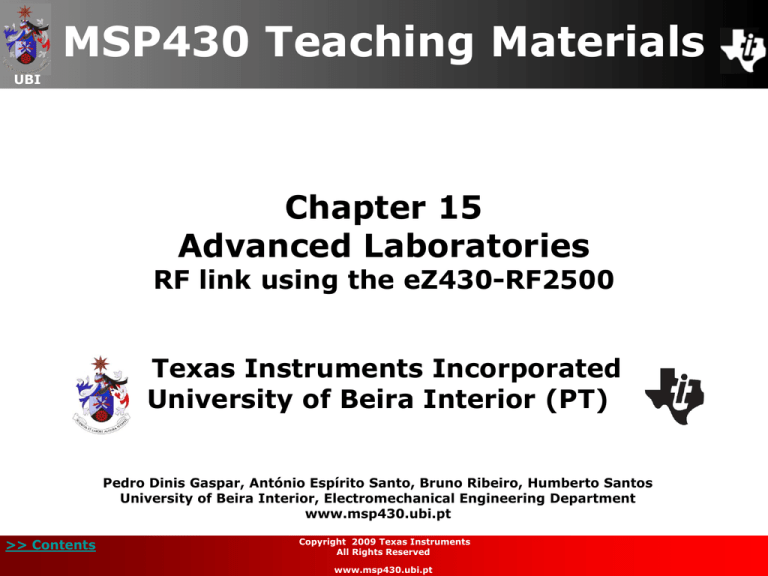
MSP430 Teaching Materials
UBI
Chapter 15
Advanced Laboratories
RF link using the eZ430-RF2500
Texas Instruments Incorporated
University of Beira Interior (PT)
Pedro Dinis Gaspar, António Espírito Santo, Bruno Ribeiro, Humberto Santos
University of Beira Interior, Electromechanical Engineering Department
www.msp430.ubi.pt
>> Contents
Copyright 2009 Texas Instruments
All Rights Reserved
www.msp430.ubi.pt
Contents
UBI
Introduction
The application
The hardware
The software
Configuration
Algorithms
New challenges
>> Contents
Copyright 2009 Texas Instruments
All Rights Reserved
www.msp430.ubi.pt
2
Introduction (1/3)
UBI
This laboratory demonstrates the operation of a small
wireless communication application;
The purpose of this laboratory is to send and receive text
messages, making use of RF links between the central
unit (base unit) and the various peripheral units (remote
units).
It is an integrated application, using some peripherals of
the MSP430, in particular, the USCIx communication
modules;
Additionally, it uses the CC2500 radio transceiver as an
interface to external devices;
Even though the application is simple, it is motivating to
the user because the IO console allows easy interaction
with the system;
>> Contents
Copyright 2009 Texas Instruments
All Rights Reserved
www.msp430.ubi.pt
3
Introduction (2/3)
UBI
This laboratory has the following objectives:
To demonstrate the importance of software organization as
a fundamental part of an embedded systems project:
• To approach the problem using a top-down approach,
applying the necessary abstraction to organize the
software into functional layers.
To give an example of the management of a complex
project, integrating together more than one functional
module:
• To develop a modular structure so that several functional
modules co-exist together within a single software
project.
>> Contents
Copyright 2009 Texas Instruments
All Rights Reserved
www.msp430.ubi.pt
4
Introduction (3/3)
UBI
This laboratory has the following objectives (continued):
Make use of the wireless communications capability of the
MSP430, demonstrating its practical advantages;
Consolidate knowledge acquired during the previous
laboratories, namely:
• From the MSP430 communications interfaces
laboratories:
– SPI mode to access the transceiver CC2500;
– UART mode to interface with the IO console.
>> Contents
Copyright 2009 Texas Instruments
All Rights Reserved
www.msp430.ubi.pt
5
The application (1/4)
UBI
This laboratory establishes communications between
various RF units;
The stations are identified by an ID, i.e., the address for
presentation to the network. When a station wants to
communicate with another station, it must use the
address of the target station in the message;
The CC2500 has several ways to communicate, which
determine the size of the messages exchanged;
In order to simplify the communication process, fixedsize address and data have been used (maximum
message size 64 bytes). This corresponds to the size of
the CC2500 FIFO.
>> Contents
Copyright 2009 Texas Instruments
All Rights Reserved
www.msp430.ubi.pt
6
The application (2/4)
UBI
CC2500 packages format:
>> Contents
Copyright 2009 Texas Instruments
All Rights Reserved
www.msp430.ubi.pt
7
The application (3/4)
UBI
This laboratory has two units with distinct functional
differences:
The code differs between the two units:
One unit contains the base station functionality:
• Receives messages from all peripheral units;
• Works as a radio beacon;
• Sends to to all remote stations;
• Acknowledges messages received.
The other unit acts as a remote station.
>> Contents
Copyright 2009 Texas Instruments
All Rights Reserved
www.msp430.ubi.pt
8
The application (4/4)
UBI
Block Diagram of the Application:
RS232 Console in PC
You Are Table#01
You Are Table#01
......
You Are Table#01
RS232 Console in PC
RS232
Remote station
ID 0x01
Remote station
ID 0x02
RS232
You Are Table#02
You Are Table#02
......
You Are Table#02
RS232 Console in PC
Messages from Base
station to Remote
station #3
Base station
ID 0x43
RS232
Messages from
Remote stations to
Base station
We Are Table#01
We Are Table#03
We Are Table#02
......
We Are Table#n
RS232 Console in PC
RS232 Console in PC
You Are Table#03
You Are Table#03
......
You Are Table#03
>> Contents
RS232
Remote station
ID 0x03
Remote station
ID 0xn
Copyright 2009 Texas Instruments
All Rights Reserved
www.msp430.ubi.pt
RS232
You Are Table#n
You Are Table#n
......
You Are Table#n
9
The hardware (1/4)
UBI
The application is ready to run on the eZ430-RF2500
hardware development kit (see Chapter 3 for details).
The devices used are the:
• CC2500 radio transceiver;
• MSP430F2274;
• RS232 interface, accessed through the USB interface,
which is available for development.
>> Contents
Copyright 2009 Texas Instruments
All Rights Reserved
www.msp430.ubi.pt
10
The hardware (2/4)
UBI
The CC2500 is a radio frequency transceiver operating in
the widely used ISM/SRD (Industrial-Scientific-Medical
/Short-Range-Devices) 2.4 GHz frequency band;
It is a low-cost device with low power consumption,
designed for consumer electronics applications.
>> Contents
Copyright 2009 Texas Instruments
All Rights Reserved
www.msp430.ubi.pt
11
The hardware (3/4)
UBI
The communications protocol uses very little data
formatting. It is up to the user to define the
communications protocol that best suits their application
and implement their own software;
The CC2500 is a low pin-out device, because it integrates
all the radio functions, except the antenna;
This device is not sufficiently independent that it can
operate without the aid of a microcontroller;
When coupled to the MSP430, connection is made
between:
• Access to internal registers: SPI interface belongs to the
USCIB0 unit;
• Status pins: GDO0 and GDO2 (P2.6 and P2.7).
>> Contents
Copyright 2009 Texas Instruments
All Rights Reserved
www.msp430.ubi.pt
12
The hardware (4/4)
UBI
CC250 RF transceiver:
>> Contents
Copyright 2009 Texas Instruments
All Rights Reserved
www.msp430.ubi.pt
13
The software (1/5)
UBI
Internal structure:
Structured in layers:
• Base layer: Hardware abstraction layer. Responsible for
separating the higher layers of software from the
hardware;
• Middle SPI layer: Ensures the communication functions
for the correct operation of CC2500;
• UART layer: Provides connection to the PC via RS232;
• CC2500 layer: Access and control functions controlling
the CC2500 (SPI and the GPIO);
• Application layer: Uses the features offered by layers at a
lower level to implement the tasks necessary for the
correct operation of the application.
>> Contents
Copyright 2009 Texas Instruments
All Rights Reserved
www.msp430.ubi.pt
14
The software (2/5)
UBI
Software structure:
Application
CC2500
UART
SPI
Hardware Definition
CC2500 + SPI +UART
>> Contents
Copyright 2009 Texas Instruments
All Rights Reserved
www.msp430.ubi.pt
15
The software (3/5)
UBI
Each layer has different functional responsibilities:
Hardware definition layer:
File
Description
TI_CC_CC1100-CC2500.h
Definitions specific to the
CC1100/2500 devices
(Chipcon’s/TI SmartRF Studio
software can assist in
generating register contents)
TI_CC_MSP430.h
Definitions specific to the MSP430
device
TI_CC_hardware_board.h
Definitions specific to the board
(connections between MSP430
and CCxxxx)
>> Contents
Copyright 2009 Texas Instruments
All Rights Reserved
www.msp430.ubi.pt
16
The software (4/5)
UBI
SPI layer:
File
Description
TI_CC_spi.h
Function declarations for hal_spi.c
TI_CC_spi.c
Functions for accessing
CC1100/CC2500 registers via SPI
from MSP430
CC2500 layer:
File
Description
cc1100-CC2500.c
Initialization of messages,
transmission and reception
functions.
TI_CC_CC1100-CC2500.h
Function declarations for cc1100CC2500.c
>> Contents
Copyright 2009 Texas Instruments
All Rights Reserved
www.msp430.ubi.pt
17
The software (5/5)
UBI
UART layer:
File
Description
hal_uart.c
Initialization of
transmission
RS232.
hal_uart.h
Function
declarations
hal_uart.c
>> Contents
Copyright 2009 Texas Instruments
All Rights Reserved
www.msp430.ubi.pt
messages
functions
and
via
for
18
Configuration (1/5)
UBI
Clearly defined start-up of the multiple
modules and the various software modules;
hardware
Important: The unit’s address needs to be changed
during compilation, to allocate a unique address.
START
Configure MSP430 IO
Initialize MS430 Interface
Put CC2500 in RX state
Power-Up reset signal
sequence to CC2500
Set device Adress
Write RF Settings to
CC2500
>> Contents
Copyright 2009 Texas Instruments
All Rights Reserved
www.msp430.ubi.pt
Enter Sleep mode 3
19
Configuration (2/5)
UBI
Base station code:
Two interrupt service routines
(ISR) and two buffers:
CC2500
RX Buffer
TX Buffer
Port2
ISR
Timer A
ISR
UART
RS232
Timer A
TX
>> Contents
Copyright 2009 Texas Instruments
All Rights Reserved
www.msp430.ubi.pt
20
Configuration (3/5)
UBI
Base station code:
• Port2 ISR:
– Enabled by GDO0, which causes a L-H transition when
it receives a valid Sync_Word;
– H-L transition at the end of a message reception;
– The contents of the received messages are sent to the
IO console via the RS232 connection;
• The Timer_A service routine is used to send a message to
check for correct reception from the remote stations
(maximum of 15);
• The two buffers are used to hold the messages:
– The transmit buffer is used to build the message for
later transmission;
– The receive buffer is used to hold the data read from
the CC2500 FIFO when a message is received.
>> Contents
Copyright 2009 Texas Instruments
All Rights Reserved
www.msp430.ubi.pt
21
Configuration (4/5)
UBI
Remote station code:
Composed of two interrupt
service routines (ISR) and
two buffers:
CC2500
RX Buffer
>> Contents
Copyright 2009 Texas Instruments
All Rights Reserved
www.msp430.ubi.pt
TX Buffer
Port2
RSI
Port1
RSI
UART
RS232
Keyboard
GPIO
TX
Switch
22
Configuration (5/5)
UBI
Remote station code:
• Port2 ISR:
– Enabled by the GDO0, which causes a L-H transition
when it receives a valid Sync_Word;
– H-L transition at the end of a message reception;
– Received message contents to IO console (RS232).
• Port1 ISR: Generated when the button is pressed,
sending the signal announcing the presence of the
remote station;
• Two buffers used to hold the messages:
– Transmit buffer is used to build the message for later
transmission;
– The receive buffer is used to hold the data read from
the CC2500 FIFO after receiving a message.
>> Contents
Copyright 2009 Texas Instruments
All Rights Reserved
www.msp430.ubi.pt
23
Algorithms (1/2)
UBI
Transmission algorithm implemented by Port1 ISR:
START ISR P1
Switch pressed?
Yes
Build a packet
Write data to TX buffer
No
Put CC2500 in TX state
Send
Packet
Wait forGDO0 to finish
Clear flag
END
>> Contents
Copyright 2009 Texas Instruments
All Rights Reserved
www.msp430.ubi.pt
24
Algorithms (2/2)
UBI
Reception algorithm used by the Port2 ISR in both
START ISR P2
stations:
Rx Buffer have
data
Yes
Read first byteof FIFO
(len byte)
No
Read len byte from FIFO
Read
packet
Read status byte
Clear flag
END
>> Contents
Copyright 2009 Texas Instruments
All Rights Reserved
www.msp430.ubi.pt
25
New challenges
UBI
This laboratory has brought together the range of ideas
and concepts taught in the CDROM. It can also be used
as the basis for other and more exciting new challenges;
Using the present laboratory as a starting point, develop
an application to exchange written messages between a
series of stations scattered inside a room, a kind of
"wireless messenger“;
The messages typed into the IO console for a particular
address would be sent by wireless support to the
console addressed.
>> Contents
Copyright 2009 Texas Instruments
All Rights Reserved
www.msp430.ubi.pt
26
New challenges
UBI
To achieve this objective, it is useful to define a small set
of user-defined commands, such as:
• Address allocation at the local station;
• Address allocation at the remote station;
• Sending a message;
• Neighbourhood screening of possible talking partners;
• Among others…
>> Contents
Copyright 2009 Texas Instruments
All Rights Reserved
www.msp430.ubi.pt
27

